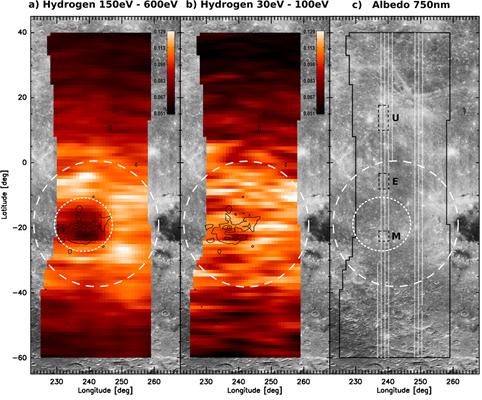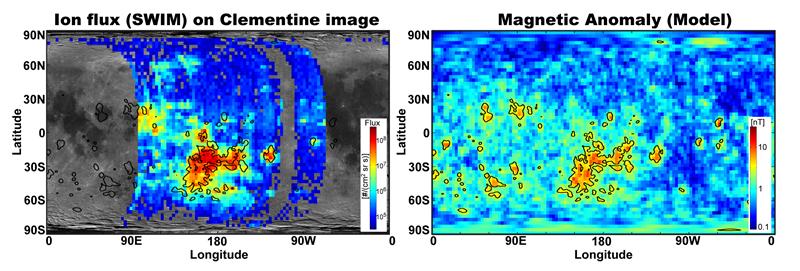Atmosphere-less bodies interact with the solar wind quite differently than the Earth. Their surfaces are exposed without any shielding by a dense atmosphere or magnetosphere, which causes them to be heavily weathered by meteoroids or the solar wind, forming a very rough and chaotic surface called regolith. So far, the solar wind was thought to be completely absorbed by regolith. However, recent explorations of the Earth's moon by the Chang'E-1, Kaguya and Chandrayaan-1 spacecrafts have revealed that this interaction is not that simple.
A significant flux of high energy particles were found to originate from the lunar surface, most probably due to the solar wind directly reflected off the Moon’s regolith.

Spatial variation of the energetic neutral hydrogen flux over the magnetic anomaly close to the Gerasimovic crater. (a) High energy hydrogen flux with energy indicates a ~50% flux reduction inside the magnetic anomaly compared to the surrounding area. (b) Hydrogen flux with lower energy of 30-100 eV fills the magnetic anomaly. (c) The albedo (reflectivity) map of the Moon with the spacecraft trajectories (white lines). Credit: Swedish Institute of Space Physics
“These results may change dramatically the way we understood the solar wind-regolith interaction so far. Since the solar wind is one potential source of water on the Moon, we need to make better models of the lunar hydrogen circulation in order to understand how water molecules form in its upper layers,” said Dr. Yoshifumi Futaana Futaana of the Swedish Institute of Space Physics at the European Planetary Science Congress in Rome. “Also, it will be possible to remotely investigate the solar wind-surface interaction on other airless bodies, such as the Martian moon Phobos or Mercury, by imaging the energetic hydrogen atoms that are reflected back to space when solar wind hits their surface.”
The current investigation was carried out with the Sub-keV Atom Reflecting Analyzer instrument which was developed in a collaboration between Sweden, India, Switzerland and Japan and flown onboard the Indian Chandrayaan-1 spacecraft. Scientists have mapped for the first time the energetic hydrogen atoms coming from the Moon, and found that up to one fifth of the solar wind protons reaching the lunar surface are reflected back to space.
"This may be a general feature of the atmosphere-less bodies, such as Mercury, meteorites and several moons of the giant planets. “In fact, during the close encounter of the European Mars Express spacecraft with Phobos in 2008, we detected signatures of reflected solar wind protons also from the surface of Martian moon Phobos,” says Futaana.

Comparison between the reflected proton flux and the magnetic anomaly distribution on the Moon. (Left) Proton flux distribution observed by the SWIM sensor mapped on the lunar map (generated by Clementine). The black line shows a contour of the lunar magnetic anomaly. (Right) Magnetic anomaly distribution model based on Lunar Prospector data. The same contour as in the left panel is overlaid here. Credit: Swedish Institute of Space Physics
However, when Chandrayaan-1 flew over a magnetic anomaly (magnetized region on the Moon surface), the scientists detected significantly less reflected hydrogen atoms meaning that the solar wind had not reached the lunar surface. In fact, the solar wind was found to be strongly deflected by an aggregation of magnetic anomalies in the southern hemisphere of the lunar far side. “We detected a strong flux of deflected solar wind protons. This clearly indicates that magnetic anomalies can shield the lunar surface from the incoming solar wind, in the same way as the magnetospheres of several planets in our solar system,” says Futaana.
“It all depends on how strong the solar wind “blows”. When the solar wind pressure is low, this “mini-magnetosphere” expands causing stronger shielding,” concluded Dr. Martin Wieser, also of the Swedish Institute of Space Physics.






Comments